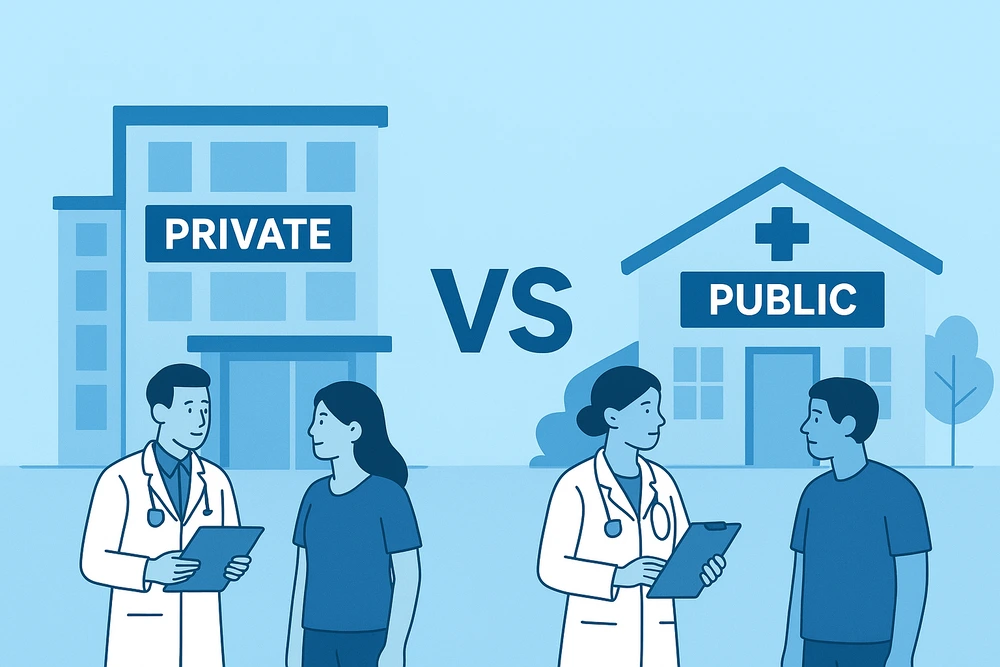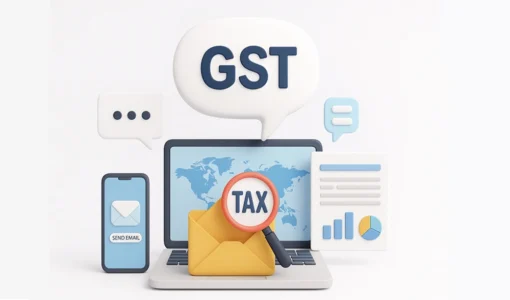Table of Contents
While the urban-rural divide is significant and the system is not without its challenges, there are still some exceptions where India’s healthcare sector shines. Despite the highest medical inflation in Asia, healthcare in India continues to attract medical tourism. Health insurance penetration is slowly but surely growing through various government and private channels.
The digital healthcare ecosystem is reducing the health burden (at least for outpatient facilities) on healthcare centers and improving the way these services are accessed. It is also unifying patient data and providing a digital interface/tech for teleconsultations or health monitoring.
However, at the heart of this system lies a critical choice: public or private healthcare. And it is not just about picking one to access medical care; it is a critical decision that impacts how quickly you get the care, how much it costs you, and how effective the treatment is. With the rising healthcare costs, this is the most important decision one can make. Therefore, it is important to understand the nuance between public and private healthcare.
It is often said that good healthcare in India is often a matter of geography, income, and information. Let’s find out if it’s truly the case, or are there any myth-breaking exceptions.
In this blog, we’ll break down the key differences, help you understand your options, and empower you with the knowledge to make an informed decision for yourself and your loved ones.
Also read: Private and Public Hospitalisation Costs in India
Decoding India’s Healthcare System
1. Public Healthcare
These government-led healthcare facilities have a broader reach (specially in rural areas), occasionally cost-exempt services, and oftentimes low-cost medical care.
However, these centers are often built on poor infrastructure. Additionally, they are underfunded, understaffed, and overcrowded, which negatively impacts their quality.
2. Private Healthcare
These centers offer better infrastructure, shorter wait time, perceived higher quality of care, and better access for specialised care.
Despite being a popular choice, private healthcare in India has frequently been criticised for providing expensive care with profit-driven aspirations in the backend and being unregulated in smaller facilities.
Quick read: Medical Inflation in India
The Good: Progress and Initiatives
Universal health coverage programs, such as Ayushman Bharat – PMJAY, have made quality healthcare more accessible to low-income families. Furthermore, these initiatives have also been instrumental in the eradication of various diseases, including polio and Tetanus.
The Challenges: What Needs Improving?
In addition to this, India has a serious shortage of healthcare workers (only 1 doctor per 1,500 people, against the WHO norm of 1:1,000). In addition to this, there are several other low-hanging fruits like fragmented/unregulated private centers, poor infrastructure, increasing burden of lifestyle diseases, and low health insurance penetration.
Recommended read: The Health Challenges of India’s Tech Professionals
What to Expect from India’s Healthcare System Today?
Expectations from Public Healthcare
- Affordability: Most services are free or can be availed at little to no cost.
- Wide Reach: Extensive network of healthcare centers, specially in rural areas.
- Preventive Focus: Strong emphasis on immunisation, maternal care, and disease control programs.
- Key Challenges: Overcrowding, limited resources, and variable quality.
Expectations from Private Healthcare
- Quality and Comfort: Modern infrastructure, specialised care, shorter wait times, and personalized care.
- Specialist Access: Better access to specialists/expert doctors and advanced treatments.
- Cost: High out-of-pocket medical expenses and expensive private insurance premiums.
- Limitations: Can be prohibitively expensive for many, specially without insurance. Also, smaller facilities are unregulated and warrant malpractices.
Relevant read: Pre and Post Hospitalisation Expenses
6 Key Differences Between Public and Private Healthcare In India
1. Accessibility
Public healthcare has little to no cost barriers and better geographical access, but these centers are often overcrowded, warranting a longer wait time and narrow access to emergency care.
Private centers are highly equipped and offer specialised/advanced treatment, but they often come at a significant financial burden without any insurance or medical coverage. These centers are rarely present in rural/remote areas, and transportation can be challenging specially during a medical emergency.
2. Cost of Treatment
Public hospitals and health centers are designed to reduce the burden on out-of-pocket expenses, making them the preferred choice for economically vulnerable groups. Most treatments, consultations, and medicines are free or heavily subsidised.
On the contrary, private hospitals charge a significantly higher amount for consultations, procedures, room rent, and medicines. Costs can be 20X higher than public hospitals. For example, an ICU in a public hospital can cost around Rs. 1,500 versus Rs. 30,000 for a private one; open-heart surgery costs roughly Rs. 95,000 in public vs. Rs. 2.8 lakh in private. Without medical coverage, treatment at a private hospital can push families into debt.
3. Quality of Care
However, a larger share of private hospitals are recognised for delivering excellent patient care and robust healthcare infrastructure that comes with better individualised care and comfort. Service quality, in terms of tangibility, empathy, reliability, and responsiveness, is rated higher in private hospitals.
Many public hospitals are also known for providing excellent care, but they are often overcrowded and face workforce shortages that severely affect patient experience and health outcomes.
4. Waiting Time
Due to efficient staffing and a low patient-to-doctor ratio, private hospitals offer quicker appointments, diagnostics, and treatment.
Average waiting time in private hospitals for OPD is around 15.5 minutes versus 20.3 minutes in public hospitals, with longer delays in emergency care.
5. Staffing & Expertise
Private hospitals attract top talent due to better support staff, competitive salaries, and better working conditions. Owing to this, access to specialists and super-specialists is easier and faster at private hospitals.
6. Insurance Ease
Traditionally, public hospitals do not accept insurance, but with the introduction of government-led insurance schemes, this is changing. With schemes like Ayushman Bharat – PMJAY, patients can get cashless treatment at empanelled public and private facilities.
The claim process for such schemes can be more bureaucratic and time-consuming compared to private care.
A Comparative View: Public Vs. Private Healthcare In India
| Feature | Public Healthcare | Private Healthcare |
| Accessibility | Extensive, especially rural | Urban-centric, limited rural reach |
| Cost | Free or subsidized | Expensive, out-of-pocket |
| Quality | Varies, often basic | Generally higher, modern |
| Waiting Time | Long | Short |
| Expertise | Qualified but overstretched | Abundant, specialist-driven |
| Insurance | Limited, improving | Widely accepted |
Public Vs. Private Hospitals: When To Choose What?
When to Choose a Private Hospital?
- Emergency Situations: When time is critical and immediate intervention is needed.
- Specialised Treatments: For complex surgeries or advanced diagnostics not available in public hospitals.
- Comfort & Privacy: If you prefer private rooms, personalized care, and better amenities.
- Insurance Coverage: If you have comprehensive health insurance that covers private care.
When to Choose a Public Hospital?
- Affordable Care: When cost is a major concern.
- Basic and Preventive Services: For immunizations, maternal and child health, and routine check-ups.
- Chronic Disease Management: For long-term treatment of conditions like diabetes, tuberculosis, or hypertension.
- Government Schemes: When eligible for benefits under government health programs.
Government Schemes That Are Bridging the Gap
1. Pradhan Mantri Jan Arogya Yojana (PMJAY) / Ayushman Bharat
- It is the world’s largest government-funded health insurance scheme and it was introduced with the aim of offering universal healthcare to Indians.
- Offers medical coverage up to Rs. 5 lakh per family per year for secondary and tertiary care at empanelled public and private hospitals.
2. National Health Mission (NHM)
- It is a flagship initiative of the Indian Government, launched in 2013, to offer universal access to equitable, affordable, and quality healthcare services for all citizens.
- Strengthens public health infrastructure, in both rural and urban areas, specially for financially vulnerable groups.
- The scheme places a strong focus on maternal and child health, communicable diseases, and strengthening the public health system.
3. Employees’ State Insurance (ESI)
- It is a comprehensive social security and health insurance program launched under the Employee State Insurance Act, 1948. And it is managed by the Employees’ State Insurance Corporation (ESIC), an autonomous body under the Ministry of Labour and Employment.
- The scheme provides financial protection, medical care, and a range of benefits to minimum wage employees (salary up to Rs. 25,000) and their dependents in case of sickness, maternity, disability, or death due to employment injury.
- Covers both public and select private hospitals for insured employees.
These government-led schemes are the essential bridge between public and private healthcare, making quality treatment more accessible and affordable for millions.
Conclusion
The rise of health insurance and government schemes is helping to make private care more accessible, while ongoing reforms are strengthening public health infrastructure. As a consumer, understanding these differences empowers you to make the best choices for your health and finances.
Onsurity is committed to making quality healthcare accessible and affordable for all, with innovative health plans that bridge the gap between public and private care.







